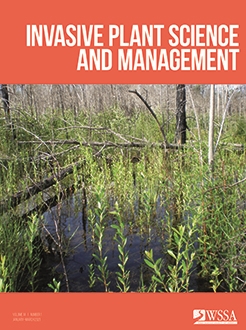Mesocosm studies were conducted in 2020 to evaluate the effects of carrier volume and application method on waterhyacinth [Eichhornia crassipes (Mart.) Solms] response to 2,4-D, glyphosate, and diquat. Carrier volumes of 935, 467, and 187 L ha–1 were applied using either a conventional stream, conventional cone, adjustable cone, or a drizzle-stream spray pattern. Reducing carrier volume from 935 L ha–1 reduced spray coverage up to 60%, depending on application method. However, reducing carrier volume did not diminish efficacy of any herbicide or application method. Alternatively, E. crassipes control from 2,4-D increased 10% to 26% when applied using 187 L ha–1 compared with 935 L ha–1. Likewise, E. crassipes biomass was reduced 91% when 2,4-D was applied using 935 L ha–1; however, treatment applied at 187 L ha–1 resulted in 99% biomass reduction. In general, 2,4-D resulted in roughly 10% greater control when conventional or adjustable cone applications were used compared with either stream applications. Eichhornia crassipes control at 7 d after treatment (DAT) from diquat increased with decreasing carrier volumes; however, treatment effects in diquat experiments were not detected at other evaluation intervals. Glyphosate efficacy was highly influenced by carrier volume, as E. crassipes control increased up to 61% when applied using 187 L ha–1 compared with 935 L ha–1. Moreover, E. crassipes biomass reduction increased from 55% in the 935 L ha–1 treatment to 97% in the 187 L ha–1 treatments. Glyphosate application methods consisting of conventional stream or conventional cone sprayers resulted in slightly increased E. crassipes control by 28 DAT; however, no differences among application methods were observed in E. crassipes biomass data. These data support further evaluations of alternative application techniques for E. crassipes control under field conditions and for other herbicides and aquatic plant species.
BioOne.org will be down briefly for maintenance on 17 December 2024 between 18:00-22:00 Pacific Time US. We apologize for any inconvenience.
How to translate text using browser tools
22 January 2021
Effect of carrier volume and application method on waterhyacinth (Eichhornia crassipes) response to 2,4-D, glyphosate, and diquat
Benjamin P. Sperry,
Jason A. Ferrell
ACCESS THE FULL ARTICLE
application technology
droplet size
solution concentration






